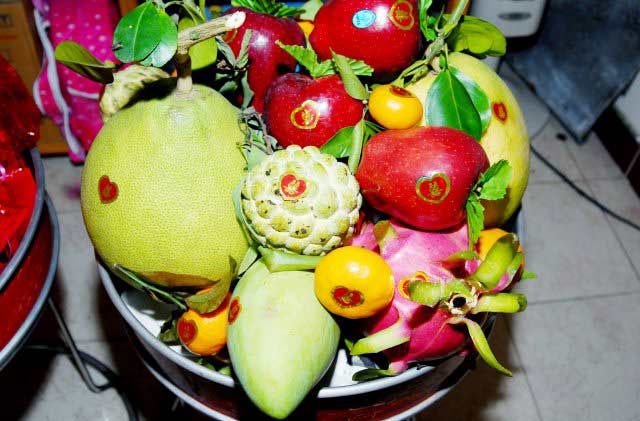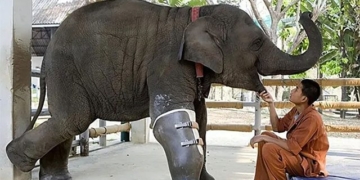The five-fruit tray is an indispensable part of the traditional Tet holiday for Vietnamese people. It serves both as a tribute to ancestors and as a wish for a prosperous and peaceful new year. Each type of fruit displayed on the altar carries its own significance, reflecting the wishes of the homeowners through its name, color, and arrangement. Therefore, families need to understand and grasp these meanings to convey their hopes and prayers for the new year.
Over time, despite many cultural changes, this tradition has been preserved among Vietnamese families due to its profound humanistic significance.
Meaning of Each Type of Fruit
Alongside traditional dishes, the five-fruit tray is a distinctive feature that evokes the essence of the Tet holiday.
The five-fruit tray typically consists of five different types of fruits, each chosen to represent the wishes and desires of the homeowner for the new year.
The five-fruit tray is a collection of five different fruits, each symbolizing a wish of the homeowner through its name and color. Additionally, the term “ngũ” (five) signifies the Vietnamese aspiration to attain the five blessings: Happiness, Wealth, Longevity, Health, and Peace.
The five fruits will display five different colors, representing the laws of nature according to the five elements: Metal (white), Wood (green), Water (black), Fire (red), Earth (yellow). Moreover, “ngũ” also symbolizes the homeowner’s wishes for a prosperous and fulfilling life: Happiness (good fortune); Wealth (richness, luxury), Longevity (long life), Health (well-being), Peace (tranquility).
From the North to the South, the types of fruits used in the five-fruit tray are diverse, symbolizing the family’s wishes, with common colors such as green (balance, peace), red, orange (good fortune), and yellow (wealth). The traditional five-fruit tray often includes fruits such as: Green bananas – Symbolizing family unity, warmth, and protection; Buddha’s hand – Representing the Buddha’s protection over the family; Yellow grapefruit – A wish for prosperity and peace; Red dragon fruit – The gathering of dragons and clouds, indicating wealth; Yellow papaya – Prosperity and abundance.
Depending on the region’s climate, products, and unique beliefs, different types of fruits may be chosen for the five-fruit tray.

The five-fruit tray expresses the wish for a prosperous new year
- Banana: Symbolizing the gathering and warmth of descendants, bringing in good fortune and protection.
- Buddha’s Hand: Representing the Buddha’s protection over the entire family.
- Grapefruit: Wishing for prosperity and peace.
- Pear or Melon: Symbolizing success and advancement.
- Orange, Tangerine: Symbolizing achievement.
- Pear: The sweet taste implies smooth and successful endeavors.
- Pomegranate: With many seeds, symbolizing many descendants.
- Peach: Representing advancement.
- Apple: Wealth and richness.
- Dragon Fruit: The gathering of dragons and clouds, indicating wealth.
- Watermelon: Round and refreshing, promising sweetness and good fortune.
- Egg: A blessing from heaven.
- Fig: Associated with abundance, health, and wealth.
- Papaya: Prosperity and abundance.
- Mango (pronounced similarly to “spend”): Wishing for no shortage in spending.
Five-Fruit Tray in Northern Vietnam
People in Northern Vietnam arrange the five-fruit tray according to the Five Elements Theory in Eastern culture, which emphasizes harmony among all things in nature. Thus, the five-fruit tray must also incorporate five colors: Metal (white), Wood (green), Water (black), Fire (red), Earth (yellow). The arrangement of colors among the fruits is designed to be visually appealing and auspicious for Tet. While there is no strict requirement for quantity, everyone ensures they have a complete offering, and the fruits must align with their meanings for worship.

Five-fruit tray for Tet in Northern Vietnam
The Northern five-fruit tray usually contains five types: Banana, Grapefruit, Peach, Persimmon, Tangerine.
Bananas in the five-fruit tray are arranged in a bunch, typically green, symbolizing unity, warmth, and gathering. Grapefruit, with its yellow color, symbolizes wealth and good fortune.
Some families replace grapefruit with Buddha’s hand (which serves to retain the spirits of the Buddha and ancestors in the home longer to bless the homeowners).
Decorative kumquat trees, Persimmons or red chili peppers are placed around the five-fruit tray for their vibrant red and yellow colors, symbolizing good fortune and success. Pineapples, with their unique aroma, express the wish for a peaceful and prosperous new year.
The traditional arrangement is: Bananas at the bottom supporting the other fruits. The central piece is either a golden grapefruit or Buddha’s hand. Surrounding fruits are arranged aesthetically. Empty spaces can be filled with golden tangerines, green apples, or ripe red chilies.
As fruits become increasingly diverse, the five-fruit tray is also becoming richer, and people are no longer strictly adhering to the term “five fruits”, allowing for arrangements of eight, nine, or ten fruits, adding clusters of juicy grapes, green apples, red chilies, or sapodilla… Even with more fruits displayed, it is still referred to as “the five-fruit tray.”

Five-Fruit Tray in Central Vietnam
In the impoverished Central region, with barren land and harsh climate, there are fewer fruits, so the people here do not adhere strictly to the form and meaning of the five-fruit tray for Tet. They primarily offer whatever is available, sincerely dedicating it to their ancestors. Therefore, each household’s five-fruit tray differs, containing any fresh and tasty fruits.

Five-fruit tray for Tet in Central Vietnam
Common fruits seen include: Dragon fruit, bananas, watermelons, custard apples, pineapples, figs, oranges, and tangerines…
Five-Fruit Tray in Southern Vietnam
In Southern Vietnam, the five-fruit tray is arranged according to the desire for “a sufficient abundance,” wishing for a new year filled with sufficiency and prosperity, corresponding to five types of fruits: Custard apple, fig, coconut, papaya, and mango. Additionally, there is often a pineapple for the wish of many descendants and a pair of watermelons with green skin and red flesh for good luck.

Five-fruit tray for Tet in Southern Vietnam
The five-fruit tray in the South clearly reflects simplicity, rusticity, and humor. Each person has a different life and wishes, knowing what is “sufficient,” but everyone just needs enough.
People in the South avoid offering certain types of fruits because the pronunciation of their names carries negative meanings, such as:
- Banana: Sounds like “to droop,” implying poor business success.
- Pear, Apple (Bomb): Sounds like “to drag on,” indicating failure.
- Orange, Tangerine: “The tangerine makes the orange suffer.”
The five-fruit tray during Tet is a distinctive cultural feature of the Vietnamese. Although it differs among regions, it ultimately reflects reverence towards ancestors and hopes for a new year filled with peace, happiness, and abundance.
Common Mistakes to Avoid When Arranging the Five-Fruit Tray
In Eastern cultural beliefs, the number five corresponds to the Five Elements Theory – the five factors that create life in the universe. The five-fruit tray with five different fruits aligns with this theory, symbolizing a wish for growth, good fortune, and wealth to come to the homeowners. Understanding the Five Elements Theory is essential when arranging the five-fruit tray to avoid common mistakes, such as not having the five colors according to the Five Elements or combining fruits that do not carry meaningful significance.
You can refer to the following color-based fruit selection:
- Metal – white: White melon, white pear…
- Wood – green: Watermelon, green bananas, green mangoes, green papayas, custard apples, jackfruit, figs, coconuts…
- Water – black: Black grapes, sapodilla, or other dark-colored fruits
- Fire – red: Red apples, persimmons, red coconuts, dragon fruits…
- Earth – yellow: Yellow oranges, yellow tangerines, yellow watermelons, yellow melons, ripe mangoes, Buddha’s hand
Fruits are becoming increasingly diverse, but this does not mean all should be placed on the five-fruit tray. Many people wish to include more types of fruits, but one should remember that the five-fruit tray should only contain fruits and should not include flowers or any other food items.
How to Choose Fruit for the Lunar New Year Celebration
- Select fruit that is freshly ripened to ensure vibrant colors and longevity in display.
- Choose firm fruit that is free from bruises or scratches and still has its stem and leaves intact.
- Avoid washing the fruit, as this can cause it to wilt or spoil quickly, especially if water remains trapped on the surface.
Why is it necessary to have a five-fruit tray on the altar during the Lunar New Year?
The origins and cultural significance of the Lunar New Year
10 Interesting Facts About the Lunar New Year Celebrations in Eastern Cultures




















































